location > dulahazra safari park/cox's bazar category > family
Our good mannered cook, always anxious to please us, informed us that lunch had been served. Food was simple but well cooked. We were so hungry that we would have been eating like a
pig unless we had to go for the tiger adventure an hour later. After lunch we returned to the verandah to identify the birds and animals we encountered by consulting the field guides. Bishawajit informed me that he had seen a 'convicted' animal in a cage in front of the park hospital for animals. While he was photographing the lonely creature he saw in its face and eyes all the grief of the world. "What kind of an animal it was?" I asked. "Yes, monkeys are tyrants of the forest. Sometimes the alpha male of the troop commits infanticide to keep its mate in heat, but how do you know that was the particular culprit animal?" "There was a notice on the cage that read 'Asami (Culprit) Banor'" "Oh! It must be an Assamese macaque monkey, not a convicted monkey," I said. "It is a typical animal of the Indian states of Assam, Tripura, Meghalaya and their adjacent districts of Bangladesh." We did not notice cloud formation in the eastern sky, now the rain came in torrents. Rain in a rainforest must be splendid. It indeed is, but not for our comfort as we had to cover a lot of ground and do some photography which would be difficult in muddy and cloudy condition. By this time the ranger came to take us to the tiger enclosure. He informed us that since the park was opened to the tourists it has been a popular visiting place for tourists heading for the Cox's Bazars beach. This year the park authorities have auctioned the right to the park for Tk 40 lakh. Next year, the amount may be doubled. The money is spent on the development of the park. I asked him why they did not collect some attractive local animals such as leopard, reticulated python, crab-eating macaque, hog badger, phayre's leaf monkey, serow or Pangolin. "Pangolin? Wait, wait. We captured three of them. We tried our best to feed them, but these termite eating scaly creatures never feed on our offerings. So we were bound to free them in the park," the ranger said. To our delight the rain stopped and the light improved considerably. The park vehicle fenced with iron bars to stop animals from attacking came to take us to the enclosure. The car has a hole in the roof to allow tourists stand up and take photos of wildlife. We crossed two gates before entering the enclosure, an area of about 30 hectares, which is well fortified with a five meter brick wall. The land is almost plain interspersed with some shallow watery depressions marked by thick low vegetation. The ranger informed us that the authorities are trying to clear the bushes to be replaced by tall grass for deer which also may provide the scope of tiger sighting. I have the experience of encountering wild tigers on several occasions in the Sundarbans, but never any hand-reared tigers, which enjoy limited freedom. I had no idea how they would behave. As our car struggled to climb a low hillock, I spotted a pair of jungle bush quail on the metal road. These small birds are seldom seen in the open.
At about 5pm, we returned from the tiger enclosure. The light was fairly good, so we visited other animal enclosures. We took the eight kilometre metal road. On the way we avoided the elephant enclosure because the four elephants there are used take tourists on a round. The ranger informed us that the elephant enclosure extends up to a marsh where sometimes a herd of wild elephants visit to see their captive relatives. The car brought us to a pool where 43 crocodiles, both marsh and salt water ones, are kept. It was not a good sight to see so many huge reptiles in such a small waterbody. We had information that salt water crocs are found only in the Sundarbans, but the ranger informed us that these creatures were collected from Teknaf after they got entangled with fishing nets. We enjoyed the evening by watching the Asiatic black bear. A fantastic aviary that contains some interesting local and foreign birds. But the most fascinating of them was the solitary arrogant hog deer stag, always trying to charge at us from the other side of the enclosure.
© thedailystar.net 2005 |
|||||||||||||

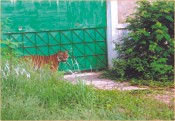

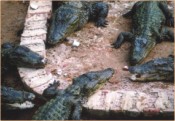
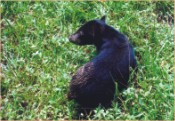
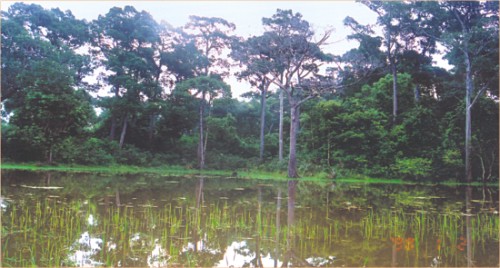
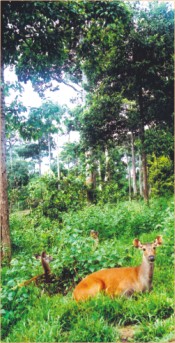 Returning to the Bungalow in the full heat of the midday sun was exhausting. After drinking a fair amount of water and tea I regained my composure both physically and mentally. Maybe last night's vigil and fatigue was taking toll on me as I felt sleepy. Suddenly, I detected a moving object on the electric pole and aligned my binocular to identify it an irrawady squirrel, a typical animal of the area. To my astonishment, the tiny animal walked over the electric wire to another pole with the support of its twisting tail, showing its amazing ability.
Returning to the Bungalow in the full heat of the midday sun was exhausting. After drinking a fair amount of water and tea I regained my composure both physically and mentally. Maybe last night's vigil and fatigue was taking toll on me as I felt sleepy. Suddenly, I detected a moving object on the electric pole and aligned my binocular to identify it an irrawady squirrel, a typical animal of the area. To my astonishment, the tiny animal walked over the electric wire to another pole with the support of its twisting tail, showing its amazing ability.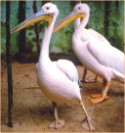
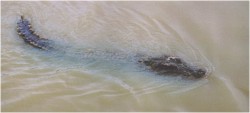
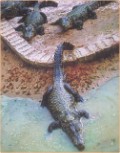
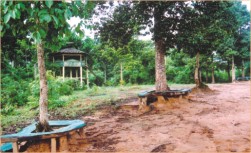
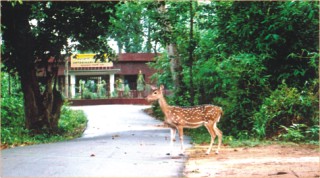
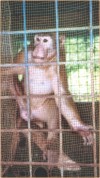 After ten minutes we stopped our car before the tigers cage. The ranger and his armoured assistants assured us that these tigers were timid in nature and we could mount on the rooftop to have a better look. We opted for the opportunity with cameras and to the jeers from our hosts, but I must admit that I felt some butterflies dancing in my stomach. As we sat comfortably on the roof, the tiger handler opened the cage door. The animals declined to leave their cage but ultimately were forced to come out. The shy sub-adult tigress appeared first, but hurriedly rushed into the bush before we could clicked cameras. Another tiger close to its prime age followed the tigress but not before staring at us to give us an opportunity to click.
After ten minutes we stopped our car before the tigers cage. The ranger and his armoured assistants assured us that these tigers were timid in nature and we could mount on the rooftop to have a better look. We opted for the opportunity with cameras and to the jeers from our hosts, but I must admit that I felt some butterflies dancing in my stomach. As we sat comfortably on the roof, the tiger handler opened the cage door. The animals declined to leave their cage but ultimately were forced to come out. The shy sub-adult tigress appeared first, but hurriedly rushed into the bush before we could clicked cameras. Another tiger close to its prime age followed the tigress but not before staring at us to give us an opportunity to click.